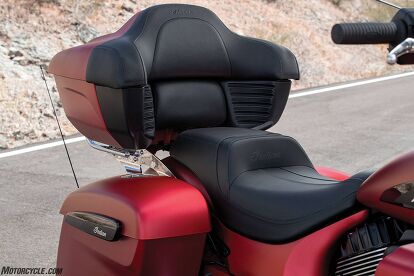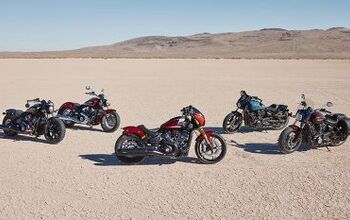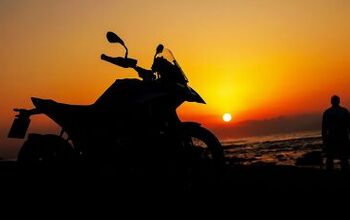2020 Indian Roadmaster Dark Horse Review – First Ride
The new American V-Twin muscle champ
Indian rolled into the octagon with a newly pumped-up Thunder Stroke 116 powerplant that threw down 126 lb-ft of torque, riding off with the 2020 Motorcycle Manufacturers Association (MMA) American V-Twin Muscle Grudge Match.
In this piston-swinging, bigger-is-better cage match – which has become an intrastate contest of competing claims – the freshly minted 1890cc Thunder Stroke engine bested Harley-Davidson’s 1917cc Milwaukee-Eight 117 by a single foot-pound of torque. Talk about one-upmanship!
Instead of introducing the 116 in a trio of limited-production, $40,000-plus CVO models, Indian is making the new motor available in seven of its 11 heavyweight bikes: From the stripped-down, $22,499 Springfield Dark Horse cruiser to a fully loaded, two-tone Roadmaster tourer retailing for $32K.
After a busy nine-hour, 250-mile day sampling Indian’s new Scout and Thunder Stroke models, I spent a weekend getting better acquainted with the more muscular mill in a newly minted Roadmaster Dark Horse, chosen for its dramatic, Chieftain-esque restyling, badass blackout treatment, and trio of matte colors: Ruby Smoke, Thunder Black Smoke, and White Smoke. In a distinct transformation to modernity, the Dark Horse shed some of its Roadmaster roots and adopted all of the Chieftain’s swagger. It also lost 25 pounds and costs $1000 less than its touring stablemate.
To straddle the bagger and tourer realms with real street cred, the Dark Horse ditched the Roadmaster’s brake-shrouding, skirted front fender, and more traditional Batwing fairing – along with its built-in driving lights, turn signals, heated seats, and other long-haul amenities – but kept the trunk, sans luggage rack. It then adopted the new-for-2019 Chieftain’s more angular, fork-mounted fairing, 19-inch front wheel, “open” front fender, and slammed saddlebags.
Thus equipped, the Dark Horse is an Indian touring bike of a different color and attitude that may effectively capture the coveted, Millennial-heavy “urban creative” and UFC-fan demographics. Sure, I’m semi-urban, kinda creative, and have great respect for MMA, but I’m also a baby boomer by birth and long-distance sportbiker by nature. Nonetheless, I jumped aboard with both feet forward.
Landing on the Dark Horse’s Extended Rogue seat, I was pleasantly surprised to find a rowdy, flexible, and hell-for-strong motor propelling this magically light-handling, 900-pound machine. With excellent fueling, the new Thunder Stroke 116 is happy loafing along anywhere above 1500 rpm, then builds smooth momentum up to the 126 lb-ft.. torque peak at 2900. From here, power flows cleanly back and forth in a 1500-rpm-wide sweet spot that can be surfed effectively while straightening twisty roads in third and fourth gears. By 4500 rpm, about 76 MO-measured rear-wheel horsepower is running wild before the motor signs off north of 5000 in an angry-sounding rage that’s full of mellow vibes the engine’s single counterbalancer seems good-naturedly tuned to pass on.
All this excitement was generated in the Standard ride mode before I figured out how to activate Sport Mode, where sharper throttle response makes the bike a bit more beastly but not unmanageable. Still, most of my time was spent in the Standard setting. In fact, the Roadmaster’s well engineered balance of power, torque, suspension compliance, braking abilities, and chassis stability produce such good manners that, if I were forced to up the pace, I’d only request sharper front stopping power and more sophisticated, adjustable suspension to help keep the bike’s natural composure.
Sure, the Dark Horse’s non-adjustable 46mm fork and air-suspended rear shock worked pretty well under a compact throttle jockey flying solo and traveling light, but what if it’s hauling a human payload of 400 pounds and another 85 worth of junk in the (bike’s) trunk, saddlebags, and fairing compartments? In this scenario, to truly master the road, the Roadmaster would benefit from suspension components that offer more than just the air-adjustable preload to level the load, maintain chassis geometry, and be tuned for optimal bump-sucking, road-hugging performance.
With this in mind, I asked Indian Product Manager Joshua Katt, who joined us on our ride around Southern California, why the Thunder Stroke needed more power. He simply said: “Customers have been asking for a 116 option from the factory, so we’re giving them what they want!”
In the first revamp of their signature motor design that came to life with the reborn company six years ago, engineers squeezed another 7 lb-ft. of torque from the Thunder Stroke 111 with a gain of 79cc via increasing cylinder bores by 2.5mm and adding new, high-flow heads, which helped boost compression 1.5 points to 11.0:1. This is all the company initially divulged.
Digging a bit deeper, we learned that securing the MMA title required more than opening Indian’s accessory catalog and bolting the popular Stage 3 Big-Bore Kit ( which Evans sampled in 2017) to the existing Thunder Stroke 111. The 116 motor sports the kit’s pistons, cylinders, heads, and fuel injectors, but its camshafts and fuel mapping are exclusive. For 2020, Indian also updated the Thunder Stroke’s connecting rods, crankshaft, and balance shaft, even allowing use of common parts for the 111 and 116.
Great, but now I wanted to know how the rods, crank, and balance shaft were updated for use in both motors. He may be a corporate guy, but Katt continued to spill the beans: “We previously offered a connecting rod in the 116 big-bore kit to ensure it was adequately robust for the increased power/torque of that package. We have now optimized a stock design that is common between the 111 and 116. The new connecting rod slightly changed the engine balance factor, so we needed to balance that with slight changes to the crankshaft and balance shaft.” While no 111-powered bikes were available to sample on our mad dash to Idyllwild, Indian brass insist that the balance factor differences are imperceptible.
Then he mentioned matter-of-factly that the 111 and 116 piston assemblies are pretty similar. I wanted to know more: “The combustion chambers increased in diameter along with the pistons,” said Katt. “The effect of this was less valve shrouding. Combined with improved port flow, the 116 motor breathes better and provides more power. Cams, fuel-injector sizing, and mapping were simply optimized for these hardware changes.”
So, about that bump in compression… Katt almost described it as organic: “The larger motor size (swept volume) with the same combustion chamber volume will give a natural rise in compression ratio. Greater charge motion in the bigger combustion area, and knock system development over time, allowed us to keep this natural increase.” Sure, that was simple, and sorta organic.
Saving rumors, innuendo, and (possibly) outright lies for last, I prodded Katt about the patent drawings and stories on this esteemed website regarding a Thunder Stroke motor with variable valve timing to meet strict Euro 5 emissions regulations that take effect in January. “The Thunderstroke 111 and 116 are currently certified at Euro 4 emissions levels but are Euro 5 capable,” was the near-practiced reply. “We are constantly assessing how new technologies can better meet our customer needs. With the updated Thunderstroke 116 we’re delivering class-leading torque and riding experience, so we do not see a need for the added cost and complexity of VVT at this time,” he said, as calm, cool and collected as a Roadmaster Dark Horse cruising down Pacific Coast Highway.
2020 Indian Roadmaster Dark Horse
+ Highs
- MMA American V-Twin Muscle Champion
- Great infotainment system
- Push-button starter and windshield
- Harmonious balance of motor and chassis performance
– Sighs
- Still too much brightwork!
- Non-adjustable fork
- Archaic rear suspension adjustment
- Obtrusive antenna
In Gear

Helmet: Shoei Neotec II $699
- Jacket: Alpinestars Ray Canvas V2 $299.95
- Pants: Alpinestars Copper Denim $229.95
- Gloves: Alpinestars Celer V2 $99.95
Boots: Alpinestars Oscar Twin Drystar Shoes $249.95
2020 Indian Roadmaster Dark Horse Specifications | |
|---|---|
| MSRP | $28,999 – $29,749 |
| Engine type | Thunder Stroke 116, air-cooled, 49-degree V-Twin |
| Displacement | 1890cc (115 cubic inches) |
| Bore and Stroke | 103.2mm x 113mm (4.063 inches x 4.449 inches) |
| Power | N/A |
| Torque | 126 lb-ft. at 2900 rpm (claimed) |
| Compression ratio | 11.0:1 |
| Valve Train | Overhead valves (2 per cylinder), pushrods |
| Charging system/battery | 42-amp max output/12V 18 Ah |
| Transmission | 6-speed |
| Fuel system | Electronic fuel injection, closed loop/54mm throttle body |
| Final drive | Belt |
| Frame | Aluminum |
| Front suspension | Telescopic fork, 46mm diameter, 4.7 inches (119mm) travel |
| Rear suspension | Single shock, 4.5 in (114mm) travel, air-adjustable preload |
| Front brake | Dual floating 300mm discs, four-piston calipers, ABS |
| Rear brake | Single floating 300mm disc, two-piston caliper, ABS |
| Front Tire | Dunlop American Elite, 130/60B19 61H |
| Rear Tires | Dunlop Elite 3, 180/60R16 80H |
| Rake / Trail | 25° / 5.9 inches |
| Wheelbase | 65.7 inches |
| Seat height | 26.5 inches |
| Fuel capacity | 5.5 gallons |
| Dry weight | 868 lbs. (claimed) |
| Colors | Ruby Smoke, Thunder Black Smoke, White Smoke |
| Warranty | Factory Warranty: 2 Years, Unlimited Miles |
More by Eric Putter















































































Comments
Join the conversation
I am still trying to figure out how 76hp can be beastly in a 950lbs bike. I don't like the primer like paints and for the money, it should be better. Considering how quickly these depreciate, they cost too much. It makes the HD make sense. The Honda and BMW even more sense.
I want an Indian